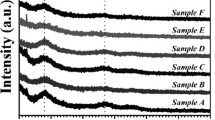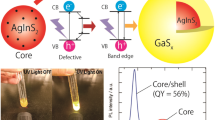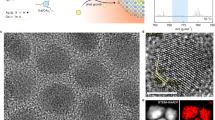Abstract
AgIn0.5Ga0.5S2 has attracted extensive attention in many fields owing to environmental friendliness, low synthetic cost, flexible and adjustable components. Appropriate direct bandgap, no forbidden transition, and high exciton binding energy make it a promising luminescent material. The evolution of the multicomponent system enriches the photoelectric properties and makes its intrinsic defects more complex. Conversely, these defects have an important effect on the photoelectric properties, thus affecting its luminescent performance. However, the microscopic mechanism of point defects corresponding to luminescence observed in experiments is mostly unknown or inferred indirectly for such semiconductors. Here, the mechanism between the microscopic defects and luminescence of AgIn0.5Ga0.5S2 is systematically revealed. Thermodynamic stability shows that AgIn0.5Ga0.5S2 is metastable and has significant competition between the secondary phases. Furthermore, the calculated defect results demonstrate that Ag-associated defects are the behind-the-scenes manipulators. Two shallow-level defects (VAg and Agi) serve as carrier providers, while four deep-level antisite defects (AgIn, AgGa, InAg, and GaAg) act as carrier annihilators. Ultimately, the study of carrier dynamics reveals the adverse effects of four deep-level antisite defects on carriers’ radiative processes. These are intended to provide important guidance for the functional application of AgIn0.5Ga0.5S2 in the field of luminescence.

摘要
AgIn0.5Ga0.5S2 由于环境友好、合成成本低、成分灵活可调等优 点在许多领域受到广泛关注. 适当的直接带隙、无禁戒跃迁和高激子 结合能使其成为一种有前途的发光材料. 多组分体系的演化丰富了光 电特性, 并使其本征缺陷更加复杂. 反过来, 这些缺陷对光电性能有重 要影响, 从而影响其发光性能. 然而, 对于这类半导体, 在实验中观察到 的与发光相对应的点缺陷的微观机制大多是未知的或间接推断的. 本 工作系统地揭示了AgIn0.5Ga0.5S2 的微观缺陷与发光之间的机制. 热力 学稳定性表明AgIn0.5Ga0.5S2 是亚稳态的并且与次生相之间存在显著的 竞争. 此外, 计算的缺陷结果表明, 与银关联的缺陷是幕后操纵者. 两个 浅能级缺陷(VAg 和Agi)充当载流子提供者, 而四个深能级反位缺陷 (AgIn, AgGa, InAg 和GaAg)充当载流子湮灭者. 最后, 载流子动力学的研 究揭示了四种深能级反位缺陷对载流子辐射过程的不利影响. 这些旨 在为AgIn0.5Ga0.5S2 在发光领域的功能应用提供重要指导.
Similar content being viewed by others
References
Huang Y, Zhang T, Wang J, et al. Design of multifunctional quinternary metal-halide perovskite compounds based on cation-anion co-ordering. Chem Mater, 2020, 32: 5949–5957
Zhao XG, Yang D, Ren JC, et al. Rational design of halide double perovskites for optoelectronic applications. Joule, 2018, 2: 1662–1673
Walsh A, Chen S, Wei SH, et al. Kesterite thin-film solar cells: Advances in materials modelling of Cu2ZnSnS4. Adv Energy Mater, 2012, 2: 400–409
Chen S, Gong XG, Walsh A, et al. Electronic structure and stability of quaternary chalcogenide semiconductors derived from cation cross-substitution of II–VI and I–III–VI2 compounds. Phys Rev B, 2009, 79: 165211
Jain S, Bharti S, Bhullar GK, et al. I–III–VI core/shell QDs: Synthesis, characterizations and applications. J Lumin, 2020, 219: 116912
Long Z, Zhang W, Tian J, et al. Recent research on the luminous mechanism, synthetic strategies, and applications of CuInS2 quantum dots. Inorg Chem Front, 2021, 8: 880–897
Wang R, Wu X, Xu K, et al. Highly efficient inverted structural quantum dot solar cells. Adv Mater, 2018, 30: 1704882
Luo S, Ke J, Yuan M, et al. CuInS2 quantum dots embedded in Bi2WO6 nanoflowers for enhanced visible light photocatalytic removal of contaminants. Appl Catal B-Environ, 2018, 221: 215–222
Tsolekile N, Parani S, Matoetoe MC, et al. Evolution of ternary I–III–VI QDs: Synthesis, characterization and application. Nano-Struct Nano-Objects, 2017, 12: 46–56
Liu G, Zhang S, Xu L, et al. Recent advances of eco-friendly quantum dots light-emitting diodes for display. Prog Quantum Electron, 2022, 86: 100415
Yue L, Li H, Liu Q, et al. Manganese-doped carbon quantum dots for fluorometric and magnetic resonance (dual mode) bioimaging and biosensing. Microchim Acta, 2019, 186: 315
Chen S, Walsh A, Gong XG, et al. Classification of lattice defects in the kesterite Cu2ZnSnS4 and Cu2ZnSnSe4 earth-abundant solar cell absorbers. Adv Mater, 2013, 25: 1522–1539
Xu Y, Chen T, Wang L, et al. From preparation to lighting and display applications of I–III–VI quantum dots. Prog Chem, 2019, 31: 1238
Kim JH, Kim BY, Jang EP, et al. A near-ideal color rendering white solid-state lighting device copackaged with two color-separated Cu–X–S (X = Ga, In) quantum dot emitters. J Mater Chem C, 2017, 5: 6755–6761
Bhattacharyya B, Pandey A. CuFeS2 quantum dots and highly luminescent CuFeS2 based core/shell structures: Synthesis, tunability, and photophysics. J Am Chem Soc, 2016, 138: 10207–10213
Ko M, Yoon HC, Yoo H, et al. Highly efficient green Zn–Ag–In–S/Zn–In–S/ZnS QDs by a strong exothermic reaction for down-converted green and tripackage white LEDs. Adv Funct Mater, 2017, 27: 1602638
Kim JH, Yang H. High-efficiency Cu-In-S quantum-dot-light-emitting device exceeding 7%. Chem Mater, 2016, 28: 6329–6335
Chen S, Gong X, Walsh A, et al. Recent progress in the theoretical study of Cu2ZnSnS4 and related chalcogenide semiconductors. Physics, 2011, 40: 248–258
Li R, Li X, Xi L, et al. High-throughput screening for advanced thermoelectric materials: Diamond-like ABX2 compounds. ACS Appl Mater Interfaces, 2019, 11: 24859–24866
Liu J, Hua E. Electronic structure and absolute band edge position of tetragonal AgInS2 photocatalyst: A hybrid density functional study. Mater Sci Semiconductor Processing, 2015, 40: 446–452
Jang JS, Borse PH, Lee JS, et al. Indium induced band gap tailoring in AgGa1−xInxS2 chalcopyrite structure for visible light photocatalysis. J Chem Phys, 2008, 128: 154717
Chen O, Zhao J, Chauhan VP, et al. Compact high-quality CdSe–CdS core-shell nanocrystals with narrow emission linewidths and suppressed blinking. Nat Mater, 2013, 12: 445–451
Yu P, Shan Y, Cao S, et al. Inorganic solid phosphorus precursor of sodium phosphaethynolate for synthesis of highly luminescent InP-based quantum dots. ACS Energy Lett, 2021, 6: 2697–2703
Yarema O, Yarema M, Wood V. Tuning the composition of multi-component semiconductor nanocrystals: The case of I–III–VI materials. Chem Mater, 2018, 30: 1446–1461
Chestnoy N, Harris TD, Hull R, et al. Luminescence and photophysics of cadmium sulfide semiconductor clusters: The nature of the emitting electronic state. J Phys Chem, 1986, 90: 3393–3399
Mao B, Chuang CH, Wang J, et al. Synthesis and photophysical properties of ternary I–III–VI AgInS2 nanocrystals: Intrinsic versus surface states. J Phys Chem C, 2011, 115: 8945–8954
Li L, Pandey A, Werder DJ, et al. Efficient synthesis of highly luminescent copper indium sulfide-based core/shell nanocrystals with surprisingly long-lived emission. J Am Chem Soc, 2011, 133: 1176–1179
Albor-Aguilera ML, Ramírez-Rosales D, González-Trujillo MA. Change from n-type to p-type conductivity on AgInS2 and AgInS2:Sn polycrystalline thin films prepared by spray pyrolysis technique. Thin Solid Films, 2009, 517: 2535–2537
Hoisang W, Uematsu T, Torimoto T, et al. Luminescent quaternary Ag(InxGa1−x)S2/GaSy core/shell quantum dots prepared using dithiocarbamate compounds and photoluminescence recovery via post treatment. Inorg Chem, 2021, 60: 13101–13109
Yoon H, Kim HS, Kim J, et al. Blue graphene quantum dots with high color purity by controlling subdomain formation for light-emitting devices. ACS Appl Nano Mater, 2020, 3: 6469–6477
Hoisang W, Uematsu T, Torimoto T, et al. Surface ligand chemistry on quaternary Ag(InxGa1−x)S2 semiconductor quantum dots for improving photoluminescence properties. Nanoscale Adv, 2022, 4: 849–857
Park YJ, Oh JH, Han NS, et al. Photoluminescence of band gap states in AgInS2 nanoparticles. J Phys Chem C, 2014, 118: 25677–25683
Hamanaka Y, Ozawa K, Kuzuya T. Enhancement of donor-acceptor pair emissions in colloidal AgInS2 quantum dots with high concentrations of defects. J Phys Chem C, 2014, 118: 14562–14568
Jagadeeswararao M, Swarnkar A, Markad GB, et al. Defect-mediated electron-hole separation in colloidal Ag2S–AgInS2 hetero dimer nanocrystals tailoring luminescence and solar cell properties. J Phys Chem C, 2016, 120: 19461–19469
Zhou X, Qiao J, Zhao Y, et al. Multi-responsive deep-ultraviolet emission in praseodymium-doped phosphors for microbial sterilization. Sci China Mater, 2022, 65: 1103–1111
Lin M, Jiang W, Yang C, et al. Oriented assembly of metal-organic frameworks and deficient TiO2 nanowires directed by lattice matching for efficient photoreversible color switching. Sci China Mater, 2022, 65: 992–999
Heyd J, Scuseria GE, Ernzerhof M. Hybrid functionals based on a screened Coulomb potential. J Chem Phys, 2003, 118: 8207–8215
Qiao L, Fang WH, Long R, et al. Elimination of charge recombination centers in metal halide perovskites by strain. J Am Chem Soc, 2021, 143: 9982–9990
Shaukat A, Singh RD. Tetragonal distortion for AIBIIICVI2 chalcopyrite compounds. J Phys Chem Solids, 1978, 39: 1269–1272
Zhang Y, Yuan X, Sun X, et al. Comparative study of structural and electronic properties of Cu-based multinary semiconductors. Phys Rev B, 2011, 84: 075127
Vidal J, Botti S, Olsson P, et al. Strong interplay between structure and electronic properties in CuIn(S,Se)2: A first-principles study. Phys Rev Lett, 2010, 104: 056401
Müller PC, Ertural C, Hempelmann J, et al. Crystal orbital bond index: Covalent bond orders in solids. J Phys Chem C, 2021, 125: 7959–7970
Nelson R, Ertural C, George J, et al. LOBSTER: Local orbital projections, atomic charges, and chemical-bonding analysis from projector-augmented-wave-based density-functional theory. J Comput Chem, 2020, 41: 1931–1940
Meng W, Wang X, Xiao Z, et al. Parity-forbidden transitions and their impact on the optical absorption properties of lead-free metal halide perovskites and double perovskites. J Phys Chem Lett, 2017, 8: 2999–3007
Jong UG, Yu CJ, Ri JS, et al. Influence of halide composition on the structural, electronic, and optical properties of mixed CH3NH3Pb-(I1−xBrx)3 perovskites calculated using the virtual crystal approximation method. Phys Rev B, 2016, 94: 125139
Peter Y, Cardona M. Fundamentals of Semiconductors: Physics and Materials Properties. Berlin: Springer Science and Business Media, 2010
Rogach AL, Kornowski A, Gao M, et al. Synthesis and characterization of a size series of extremely small thiol-stabilized CdSe nanocrystals. J Phys Chem B, 1999, 103: 3065–3069
Protesescu L, Yakunin S, Bodnarchuk MI, et al. Nanocrystals of cesium lead halide perovskites (CsPbX3, X = Cl, Br, and I): Novel optoelectronic materials showing bright emission with wide color gamut. Nano Lett, 2015, 15: 3692–3696
Karunagaran N, Ramasamy P. Investigation on synthesis, growth, structure and physical properties of AgGa0.5In0.5S2 single crystals for mid-IR application. J Cryst Growth, 2018, 483: 169–174
Purohit M, Meena SK, Dashora A, et al. Bandgap engineering of Ag-GaS2 for optoelectronic devices: First-principles computational technique. In: Kalam A, Niazi K, Soni A, et al. (eds). Intelligent Computing Techniques for Smart Energy Systems: Proceedings of ICTSES 2018. Singapore: Springer, 2020
Xu J, Liu JB, Liu BX, et al. Intrinsic defect physics in indium-based lead-free halide double perovskites. J Phys Chem Lett, 2017, 8: 4391–4396
Wang R, Dou B, Zheng Y, et al. Investigation of Ag(Ga,In)Se2 as thin-film solar cell absorbers: A first-principles study. Sci China-Phys Mech Astron, 2022, 65: 107311
Cichy B, Olejniczak A, Bezkrovnyi O, et al. Defects mediated charge disturbance in quantum-confined AgxS/AgInS2 random alloys—Toward slowly decaying quantum dot emitters. J Alloys Compd, 2019, 798: 290–299
Lax M. The franck-condon principle and its application to crystals. J Chem Phys, 1952, 20: 1752–1760
Zhang HS, Shi L, Yang XB, et al. First-principles calculations of quantum efficiency for point defects in semiconductors: The example of yellow luminance by GaN:CN + ON and GaN:CN. Adv Opt Mater, 2017, 5: 1700404
Dreyer CE, Alkauskas A, Lyons JL, et al. Radiative capture rates at deep defects from electronic structure calculations. Phys Rev B, 2020, 102: 085305
Uematsu T, Tepakidareekul M, Hirano T, et al. Facile high-yield synthesis of Ag-In-Ga-S quaternary quantum dots and coating with gallium sulfide shells for narrow band-edge emission. Chem Mater, 2023, 35: 1094–1106
Shi R, Fang Q, Vasenko AS, et al. Structural disorder in higher-temperature phases increases charge carrier lifetimes in metal halide perovskites. J Am Chem Soc, 2022, 144: 19137–19149
Huang K, Rhys A. Theory of light absorption and non-radiative transitions in F-centres. Proc R Soc Lond A, 1950, 204: 406–423
Wang X, Meng W, Liao W, et al. Atomistic mechanism of broadband emission in metal halide perovskites. J Phys Chem Lett, 2019, 10: 501–506
Acknowledgements
This work was financially supported by the Natural Science Foundation of Jiangsu Province (BK20180071), the Fundamental Research Funds for the Central Universities (30919011109), Qing Lan Project of Jiangsu Province, and the Six Talent Peaks Project of Jiangsu Province (XCL-035).
Author information
Authors and Affiliations
Contributions
Author contributions Zeng H, Zhang S and Liu G conceived the idea and directed the project. Liu G analyzed the data and wrote the manuscript. All authors commented and revised the manuscript.
Corresponding authors
Ethics declarations
Conflict of interest The authors declare that they have no conflict of interest.
Additional information
Supplementary information Supporting data are available in the online version of the paper.
Gaoyu Liu is a PhD candidate at Nanjing University of Science and Technology. His current research focuses on defect regulation and carrier dynamics in eco-friendly luminescent semiconductors.
Shengli Zhang received his PhD degree from Beijing University of Chemical Technology in 2013. He then joined the MIIT Key Laboratory of Advanced Display Materials and Devices, Institute of Optoelectronics & Nanomaterials, Nanjing University of Science and Technology. His research interests are focused on electronic or optoelectronic devices and applications.
Haibo Zeng received his PhD degree from the Institute of Solid State Physics, Chinese Academy of Sciences in 2006. Now he is the leader of MIIT Key Laboratory of Advanced Display Materials and Devices, Institute ofOptoelectronics & Nanomaterials. His current research focuses on QDs (synthesis, optics, photodetectors and LEDs).
Electronic supplementary material
40843_2023_2680_MOESM1_ESM.pdf
Supplementary materials: Unveiling the Dual Role of Silver-Associated Defects: The Manipulators of Luminescence and Carrier Dynamics in Eco-Friendly AgIn0.5Ga0.5S2
Rights and permissions
About this article
Cite this article
Liu, G., Xu, L., Hu, Y. et al. Unveiling the dual role of silver-associated defects: the manipulators of luminescence and carrier dynamics in eco-friendly AgIn0.5Ga0.5S2. Sci. China Mater. 67, 214–222 (2024). https://doi.org/10.1007/s40843-023-2680-x
Received:
Accepted:
Published:
Issue Date:
DOI: https://doi.org/10.1007/s40843-023-2680-x




